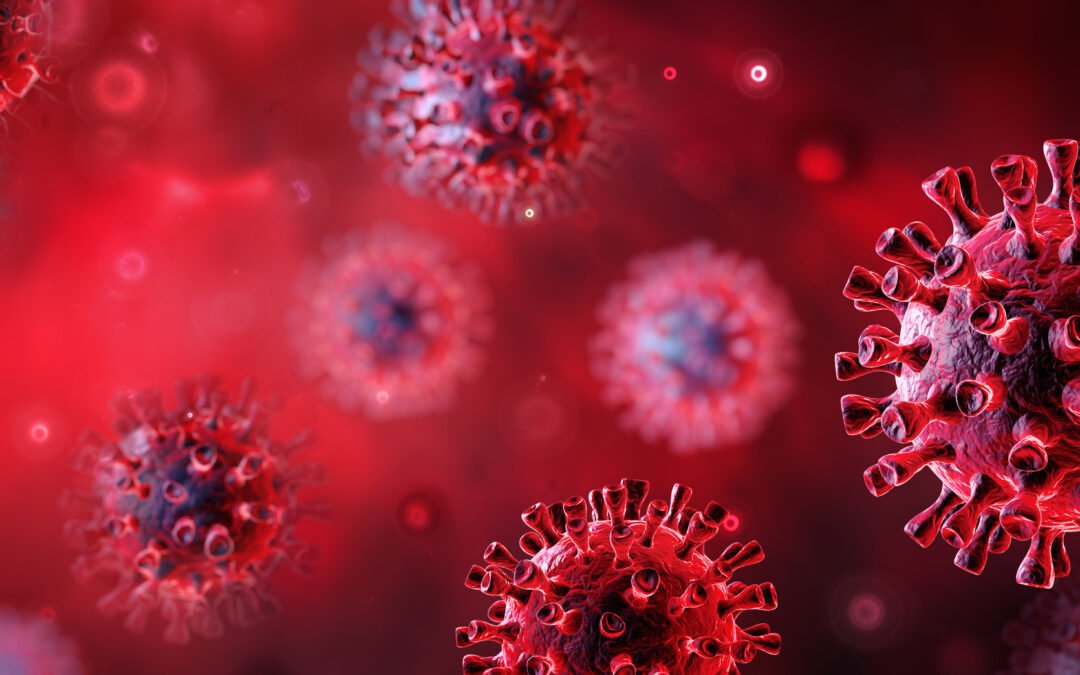The spike protein (S protein) is a SARS-CoV-2 virus (coronavirus) component that helps the virus enter healthy cells. It latches onto receptors called ACE2 (angiotensin-converting enzyme 2), penetrating host cells and causing infection. The spike protein forms a structure called a spike on the outside of an enveloped virus. It’s what gives coronaviruses their crown-like appearance. The word corona is Latin for “crown.”
The spike protein is the largest structural protein in the virus. It consists of two main subunits, S1 and S2, each with distinct functions. Both can be problematic in the body. The spike protein is one of 23 proteins that’s in the COVID virus and the vaccine. There may be a difference between getting it through the virus or the vaccine. The vaccine uses messenger RNA (mRNA) encapsulated by a lipid nanoparticle layer to deliver instructions for making the spike protein. When you get the spike protein from the infection, it will only infect those cells with ACE2 receptors that the virus binds to.
A recent study1,2 shows that spike protein may be potentially harmful, whether from natural infection or vaccination. It’s not quickly broken down by the body3 and can cause adverse effects.4 More recent studies show that the nanoparticle carrier for synthetic mRNA is potentially inflammatory, crosses membranes (blood-brain barrier), and distributes widely in the body.5
Adverse Effects of the Spike Protein2
Many studies are emerging showing how the spike protein can adversely affect the cardiovascular, respiratory, neurological, and immune systems. It may also have autoimmune implications and potential effects on cancer. Here are some ways the spike protein can impact the body, whether from natural COVID-19 infection or vaccination.
Mitochondria
The mitochondria are often called the “powerhouses” of the cell. Within the cells, they generate energy by converting nutrients into a usable form. Mitochondria provide the necessary energy that powers various cell functions. Dysfunctional mitochondria are linked to multiple diseases, including metabolic disorders, degenerative diseases, and aging-related conditions. The spike proteins can also affect the cellular function of the mitochondria in the lungs and the cardiovascular system.6
Since one of the major symptoms of chronic or Long COVID is fatigue, scientists have hypothesized that it may be caused by spike protein damage to the mitochondria. This can result from damaged or dying mitochondria that cause a lack of energy.
Cardiovascular
The spike protein may be involved with heart cell dysfunction and injury to the lining of blood vessels, leading to myocarditis.7 Other studies show how the spike protein damages endothelial4 function. Spike proteins can stimulate heart cells to produce inflammation and change platelets, leading to blood clots. This vascular inflammation may be the most significant mechanism in developing Long COVID, a chronic condition.
Neurological
The spike protein may be a major factor in central nervous system diseases. Studies show that spike-induced vascular inflammation disturbs the blood-brain barrier and exacerbates Alzheimer’s disease.8 In fact, the association between Alzheimer’s disease and severe COVID-19 is well-documented. People with minimal cognitive conditions may develop Alzheimer’s after viral infection. Neurological symptoms and cognitive impairment are a feature of acute COVID-19, vaccination injuries, and, in some cases, Long COVID.
Immune System
If the amount of spike proteins is too high, it can cause an overstimulation of the immune system and may induce the immune system to attack its own cells (autoimmunity). In fact, inflammatory or autoimmune conditions can worsen following a viral infection.9 A recent study by Vojdani10 and colleagues discovered that COVID-19 antibodies reacted with 28 different tissue antigens, possibly accelerating or exacerbating autoimmune conditions. These researchers expressed concern that the vaccine might be trading a lower risk of COVID-19 for a higher risk of a future autoimmune disorder.
Cancer
The spike protein interacts with cancer suppressor genes and has toxic effects inside cells. Experimental studies show that SARS-CoV-2 can induce or reactivate some cancers since it affects the mechanisms that play a role in cell regulation, inflammation, and proliferation.11
Could the Spike Protein be Responsible for Long COVID?12
Many people infected with COVID-19 develop a syndrome a few months after the initial infection. This is known as post-acute COVID or long-COVID and occurs in 30-50% of people. Long COVID involves multisystem symptoms, mainly persistent fatigue and cognitive impairment. Some people with Long-COVID have not recovered even7 or more months after the initial infection and continue to suffer from systemic and neurological symptoms. Some damaging effects, especially in the brain, may be caused by the spike protein’s direct action, which can persist in Long COVID for months or even years. Preventing spike-related detrimental effects is essential.
The term “spikeopathy” was recently coined13 since the spike protein is pathogenic (capable of causing disease) and able to cause a wide variety of diseases and syndromes. The question is, how do we get the spike proteins out of the body?
How to Detox the Spike Protein
While direct detoxification of the spike protein is complex, specific nutrients and health practices can support the immune system, lower inflammation, and promote overall health.
Nattokinase
Nattokinase is an enzyme derived from natto, a traditional Japanese fermented soybean dish. It is known for its fibrinolytic (clot-dissolving) properties and cardiovascular benefits. Recent studies14 and ongoing research suggest that nattokinase’s enzyme activity plays a significant role in spike protein degradation and may even inhibit SARS-CoV-2 infection.
Bromelain
Bromelain is a proteolytic (protein-digesting) enzyme from pineapple stems. It has anti-inflammatory and anticoagulant activity. One study15 showed that bromelain can obstruct SARS-CoV-2’s entry into cells by disrupting the spike protein. Bromelain exerts multiple actions against the spike protein’s toxic effects. It is a safe supplement with low toxicity, but it can increase bleeding risk in some people on certain medications.
N-acetylcysteine (NAC)
N-acetylcysteine (NAC) is a supplement form of the amino acid cysteine known for its antioxidant properties. It is a precursor to glutathione, one of the body’s most important antioxidants. While NAC doesn’t directly degrade the spike protein of SARS-CoV-2, it can contribute to the overall reduction of viral replication and the inflammatory response, indirectly affecting the virus’s ability to cause harm.
Curcumin
Curcumin is derived from turmeric root, a member of the ginger family of plants. It is well-known for its anti-inflammatory, antioxidant, antiviral, and anti-fibrotic properties. Curcumin can obstruct the spike protein’s binding sites and block SARS-CoV-2 entry into cells.16 This nutrient has been used in well-studied spike protein detox protocols.
Lithium
Lithium is an essential trace element that’s not widely recognized. In prescription form, it’s used to treat bipolar disorder. However, natural lithium orotate may be a key element in disrupting the neuroinflammation caused by the spike protein.17 More research is needed to confirm its benefits for long-COVID and other conditions that affect brain health.
Several other nutrients help reduce the spike protein’s toxic effects, including quercetin, rutin, luteolin, vitamin C, vitamin D, pyrroloquinoline quinone (PQQ), melatonin, lipoic acid, resveratrol, phosphatidylcholine, selenium, and magnesium. Potentially beneficial herbs include dandelion root, black cumin seed, and green tea extract. Many of these nutrients work by supporting the mitochondria and immune system. It’s always best to work with knowledgeable health practitioners when you have complex conditions like detoxing from the spike protein or supporting Long-COVID.
Healing From Long-COVID
Whether or not the spike protein is responsible for the damaging effects that lead to Long-COVID, a syndrome that can persist for over a year, it’s essential to take a comprehensive approach to restoring the body. Sanoviv Medical Institute has identified many treatable underlying causes, including inflammatory conditions, micronutrient deficiencies, structural abnormalities, environmental triggers, bioenergetic imbalances, mind-body issues, and lifestyle conditions – all contributing to overall dysfunction and decreased quality of life. Consider Sanoviv’s Long-COVID Treatment Program for an integrative approach to healing.
REFERENCES
- Theoharides TC. Could SARS-CoV-2 Spike Protein Be Responsible for Long-COVID Syndrome? Mol Neurobiol. 2022 Mar;59(3):1850-1861. doi: 10.1007/s12035-021-02696-0. Epub 2022 Jan 13. PMID: 35028901; PMCID: PMC8757925.
- Parry PI, Lefringhausen A, Turni C, Neil CJ, Cosford R, Hudson NJ, Gillespie J. ‘Spikeopathy’: COVID-19 Spike Protein Is Pathogenic, from Both Virus and Vaccine mRNA. Biomedicines. 2023 Aug 17;11(8):2287. doi: 10.3390/biomedicines11082287. PMID: 37626783; PMCID: PMC10452662.
- Brogna C, Cristoni S, Marino G, Montano L, Viduto V, Fabrowski M, Lettieri G, Piscopo M. Detection of recombinant Spike protein in the blood of individuals vaccinated against SARS-CoV-2: Possible molecular mechanisms. Proteomics Clin Appl. 2023 Nov;17(6):e2300048.
- Lei Y, Zhang J, Schiavon CR, He M, Chen L, Shen H, Zhang Y, Yin Q, Cho Y, Andrade L, Shadel GS, Hepokoski M, Lei T, Wang H, Zhang J, Yuan JX, Malhotra A, Manor U, Wang S, Yuan ZY, Shyy JY. SARS-CoV-2 Spike Protein Impairs Endothelial Function via Downregulation of ACE2. bioRxiv [Preprint]. 2020 Dec 4:2020.12.04.409144. Update in: Circ Res. 2021 Apr 30;128(9):1323-1326.
- Conny Turni and Astrid Lefringhausen (2022) COVID-19 vaccines – An Australian Review. Journal of Clinical & Experimental Immunology. 7(3):491-508.
- Huynh TV, Rethi L, Lee TW, Higa S, Kao YH, Chen YJ. Spike Protein Impairs Mitochondrial Function in Human Cardiomyocytes: Mechanisms Underlying Cardiac Injury in COVID-19. Cells. 2023 Mar 11;12(6):877.
- Imig JD. SARS-CoV-2 spike protein causes cardiovascular disease independent of viral infection. Clin Sci (Lond). 2022 Mar 31;136(6):431-434.
- Nuovo GJ, Suster D, Sawant D, Mishra A, Michaille JJ, Tili E. The amplification of CNS damage in Alzheimer’s disease due to SARS-CoV2 infection. Ann Diagn Pathol. 2022 Dec;61:152057.
- Shay Y, Kenig A, Tsemach-Toren T, Amer R, Rubin L, Hershkovitz Y, Kharouf F. Autoimmune phenomena following SARS-CoV-2 vaccination. Int Immunopharmacol. 2021 Oct;99:107970.
- Vojdani A, Vojdani E, Kharrazian D. Reaction of Human Monoclonal Antibodies to SARS-CoV-2 Proteins With Tissue Antigens: Implications for Autoimmune Diseases. Front Immunol. 2021 Jan 19;11:617089. doi: 10.3389/fimmu.2020.617089. PMID: 33584709; PMCID: PMC7873987.
- Jahankhani K, Ahangari F, Adcock IM, Mortaz E. Possible cancer-causing capacity of COVID-19: Is SARS-CoV-2 an oncogenic agent? Biochimie. 2023 Oct;213:130-138.
- Theoharides TC. Could SARS-CoV-2 Spike Protein Be Responsible for Long-COVID Syndrome? Mol Neurobiol. 2022 Mar;59(3):1850-1861.
- Henrion-Caude, A. Spikopathy: The Pathology of the Spike Protein. Conference Presentation, General Assembly Meeting, World Council for Health. worldcouncilforhealth.org. 2021. Available online.
- Tanikawa T, Kiba Y, Yu J, Hsu K, Chen S, Ishii A, Yokogawa T, Suzuki R, Inoue Y, Kitamura M. Degradative Effect of Nattokinase on Spike Protein of SARS-CoV-2. Molecules. 2022 Aug 24;27(17):5405. doi: 10.3390/molecules27175405. PMID: 36080170; PMCID: PMC9458005.
- Kritis P, Karampela I, Kokoris S, Dalamaga M. The combination of bromelain and curcumin as an immune-boosting nutraceutical in the prevention of severe COVID-19. Metabol Open. 2020 Dec;8:100066.
- McCullough PA, Wynn C, Procter BC. Clinical Rationale for SARS-CoV-2 Base Spike Protein Detoxification in Post COVID-19 and Vaccine Injury Syndromes. Journal of American Physicians and Surgeons Volume 28 Number 3 Fall 2023, 90-93.
- Nehls, MD, PhD, Michael, Lithium, the Essential Trace Element, December 2023 – michaelnehls.substack.com

